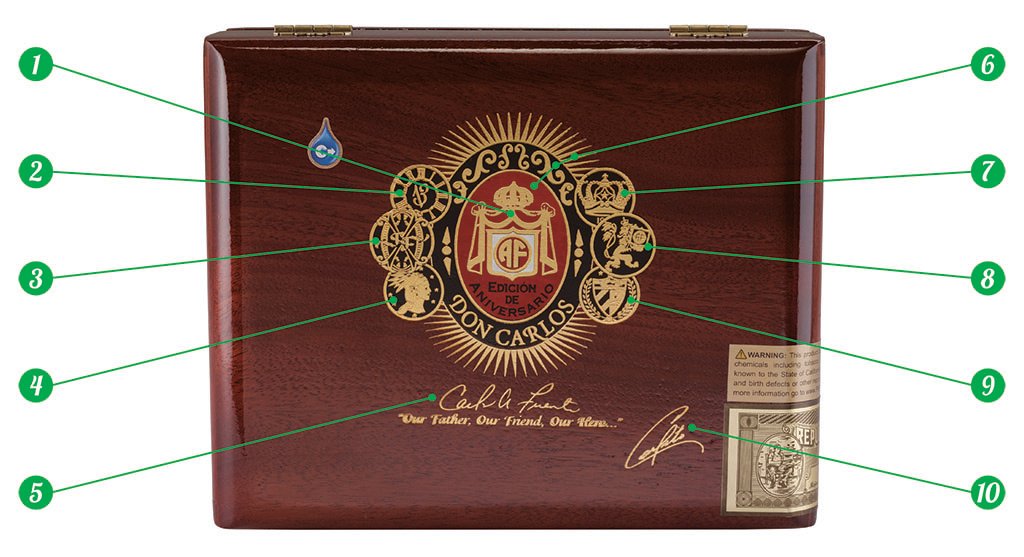All about cigars
Cigar boxes decoded : Arturo Fuente Don Carlos
Discover the history of smoking through the art of the Fuente Don Carlos cigar box.
Beyond the blend and the taste, the box can tell you the story of a cigar. It's art and, in many cases, a very personal expression of a cigar maker. "Everything has a meaning", says Liana Fuente aboutArturo Fuente Don Carlos, his favorite cigar. "Don Carlos was my grandfather's blend, and he loved it. Until the day he died, he always had two sticks in his pocket - one to give to a guest, and another for him to smoke." The box was designed by her father, Carlos "Carlito" Fuente Jr, who she says is "very attached to traditions" - so we asked Liana to decode Don Carlos, and share with you her comments on those traditions.
- Fuente family crest: The classicArturo Fuente has a regal appearance, framed by golden curtains that are drawn to reveal the crest. Edición de Aniversario means "anniversary edition" in Spanish.
- Clock : A nod to the Fuente motto, "We will never press the hands of time". Inside is the number 13, Carlos Fuente Sr.'s lucky number.
- Opus X: The "X" stands for Project X, the original X opus. "FF" stands for Fuente Fuente, father and son. You continue to see this motif in all our work."
- Tobacco goddess: called El Indio, Cuban folklore has it protecting the tobacco fields. Carlito learned it from his grandfather, Arturo, at a very young age, and it appears on many Fuente boxes and tapes.
- The signature of Carlos A. Fuente Sr.
- Gold, black and red: "These are our brand colors. They signify strength. They're timeless. My father always loved these colors."
- The crown: Carlito uses this symbol to honor previous generations of the family, who sold tobacco to the kings and queens of Spain. "My great-grandfather, when he came to the United States, we were de la Fuente. But my grandfather was like, 'I'm poor, I'm not worthy of being a de la'... so it became Fuente. He changed our name."
- Leo : The lion has always been part of the family," says Liana, noting that it appears in many versions of the Arturo Fuente logo (usually in pairs). Carlito has updated the image of the lion to bear the family crest.
- The Cuban coat of arms : Cuba's official heraldic symbol. Liana says: "This is where we come from. It represents us.
- Carlito Fuente's signature.
Cigar boxes: More than just marketing
Clearly, this Don Carlos cigar box isn't just about marketing: it's a personal expression of Carlito's pride in the work and worth of his family. Of course, not all boxes are so ornate, but even cigar boxes with the most minimalist designs still bear marks that represent something important to, or about, the person who made them.
This is one of the (many) reasons why the cigar industry was in an absolute uproar when the US Food and Drug Administration published its 2016 Final Deeming Rule. The FDA's plan was to place huge warning labels on the packaging of premium cigars. This triggered its own series of lawsuits, brought by cigar manufacturers who argued that the requirement not only stifled creativity and advertising, but also deprived them of their First Amendment right to free speech.
Fortunately, this part of the rule was removed a month ago when the Washington judge overseeing the industry's fight with the FDA determined that these massive warning label requirements were illegal.
Why cigars arrive in boxes
As we move into art, it's interesting to consider why cigars ended up in boxes in the first place.
In a word... taxes.
Tony Hyman, writer/historian and curator of a cigar museum, set the record straight for Aficionado some time ago, when he called President Abraham Lincoln:
"Desperate to raise war revenues, the beleaguered President Lincoln imposed taxes on a long list of 19th-century "luxuries," including soap, perfume, playing cards, photographs, bank checks and patent medicines. In 1863, he also called for a tax on alcohol and tobacco. But it's one thing to impose a tax, it's quite another to collect it.
As Hyman recounts, cigars in those days were shipped from the factory in barrels and then sold by the stick, or perhaps by the handful. By passing a law requiring all cigars, "foreign or domestic", to be packed in wooden boxes (quantities varied from 25 to 250 cigars) - it gave tax officials "a place to stick a stamp proving that taxes had been paid".
Art on cigar boxes
In 1900, cigars were serious business: four out of five American men smoked them, resulting in a huge "connoisseur culture" that would have put the cigar boom of the 90s to shame. We're talking about billions of cigars, handmade, all packed in boxes.
That's when cigar manufacturers became marketing specialists. All the cigar boxes on the shelf looked the same, so they had to find a way to stand out from the competition. To do this, they beautifully decorated the box with a neat presentation to match the luxurious cigarettes inside. Scenes depicted traditional Cuban farms and fields, or the indigenous peoples who introduced tobacco to Europeans. Others featured prizes, logos, insignia, famous people... anything that represented "the good life" and caught the cigar smoker's eye - and wallet.
Take a closer look
Since that time, cigar manufacturers have brought thecigar box art to an even higher level. The Don Carlos above is a good example. What's strange - in fact, we'll call it my piss - is how often so many cigar boxes end up in the trash. Cigar makers pay attention to every little detail of cigar boxes and bands, as Gary said in this post, wondering "how often they have to go completely unnoticed by us cigar smokers".
No wonder so many of us keep our boxes empty - it's almost insulting not to.
These cigar boxes contain works of art, all of which deserve to be appreciated. So I'll leave you with the same advice Gary gave about taking your cigar ring off: "Look at it closely. A lot of thought went into creating it".
Cigar Boxes Decoded is an occasional series from Cigar Advisor.

